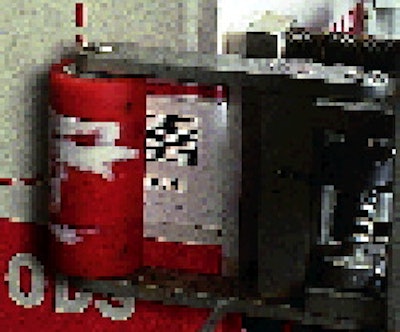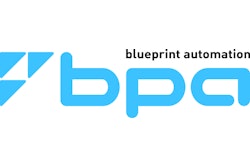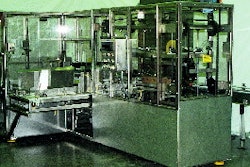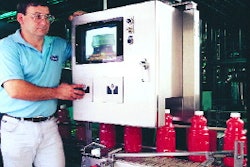Reusing corrugated cases has long been a trick of the snack food industry to cut packaging costs. For many manufacturers, cases remain within the confines of their route-delivery distribution system. But once those cases are knocked down and returned to manufacturing, they're often too flimsy to be erected, packed and sealed on conventional equipment. "Used" cases typically must be erected by hand, even for large-volume producers. Snack maker Herr Foods, Nottingham, PA, believes it's one of the first to buck the trend. In February '96, it finished installing five case packers from Blueprint Automation (Richmond, VA) that were custom-made specifically to erect, pack and seal used cases. The cases are used on five lines that pack a variety of bagged snack foods including pretzels, popcorn, cheese curls and tortilla chips. The products are sold in the Northeast and Mid-Atlantic regions under the Herr's brand name. What makes the Blueprint machines different is the degree of control they exert over the case, according to Steve Moran, plant engineer. "In the past, we've experimented with case erectors that have had problems controlling the flaps. These machines positively control every single flap on that box," he explains. "There's no chance of a flap bending in the wrong direction or hanging down where it shouldn't." Part of the solution is a modified case design. For this application, Herr's switched to a special self-locking design that eliminates the need for adhesives or tapes. That means cases come back free of any tape or adhesives. Special die cuts in the minor flaps allow the corners of the major flap on the box top to be folded in automatically. The bottom flaps were also similarly designed to be self-locking. Cases are 200#-test, C-flute, and are purchased from several suppliers. Multiple trips Moran emphasizes that not every case is reusable. In rough numbers, Moran says Herr's ships almost twice the number of cases it buys. At each of Herr's 20-odd distribution branches, damaged or otherwise unusable cases that are returned by route salespeople are sorted out of the system. A second such sortation occurs at Herr's Nottingham headquarters production facility. Cases that do make it through the recovery and sortation process typically make at least two or three trips. Indeed, four or five trips isn't unusual, according to Moran. Even so, the payback of these machines is not dependent upon the recovery of cases or even the number of trips each case makes. Cases were being reused at about the same rate before the installation of the equipment. The real savings are in labor. Previously manual case-packing required one to two people for each of the five lines. Today, those people are freed up for other tasks. Further, no new operators were added; the machines require attention from bagger operators only for replenishment or to clear an occasional jam. With two and sometimes three shifts, Moran estimates the return on the investment at two years. A unique twist to this application is a Universal corner labeler from Park Products (St. Petersburg, FL) that's integrated into the case packer. Elmark Packaging (West Chester, PA), which distributes the labeler, modified it to fit in the small space allotted to it. This label's bar code is then scanned in Herr's automated warehouse for automatic sorting and palletizing (see sidebar). "The case packer automatically erects, fills and closes each case, and sends it out in the warehouse without anyone ever touching the case," says Moran. Arms do the work The case packers are installed on five lines in Herr's allied snacks area, which manufactures all snacks except potato chips. Each case packer is connected to existing vertical f/f/s equipment. The machines produce bags that range from 4 to 20 oz, at speeds from 12 to 45 bags/min. Case counts range from 9 to 16 bags and finished output averages two to three cases/min. PW had a chance to see the machines in action during a recent visit. Case erecting starts out as operators load used (or new) case blanks in the machine's horizontal stacking magazine. The entire magazine indexes forward into the machine, permitting a second stack to be created while the machine uses up the first. A vacuum head lowers and attaches to the surface of the corrugated. As the head elevates, the relaxed blank opens up by gravity, but doesn't square up. Squaring is handled by a series of pneumatic arms that push in from either side. Additional arms push down and in on the major and minor flaps that form the bottom of the case. A final arm gives a good poke to the case bottom, causing the flaps to lock one against another. The vacuum head continues to retain its grip until the case is summoned by the loading section. When product is ready to be loaded, the vacuum head holding the case moves forward and then down, depositing the case into the loading cassette. The case is top-loaded as it sits on its side so that horizontally layered bags are simply pushed into the case. When the case is eventually turned upright, bags are vertically oriented, which provides protection during transit. Bag collation Meanwhile, at the other end of the machine, bags are conveyed from the vf/f/s machine up an inclined conveyor into the collating area. The conveyor is equipped with two belts that compress the bag as it travels, testing for seal integrity. Airtight bags resist the compression, passing inspection. Sensors detect a lack of resistance from leaky bags, signalling a reject. At the top of the inclined conveyor, bags are dropped into a mechanism that meters the bags into the collating section at appropriate intervals. Bags are dropped intermittently onto what looks like two parallel rubber tank treads that support the bags at each end. After each bag is deposited, the treads advance the distance of one bag width, until an entire row of bags is formed. At that point, the treads drop away and the bags drop as a group a short distance onto a staging platform. A ram pushes in from one side, squaring the bags as a group. The platform is then withdrawn, whereupon the bags drop further into a containment bin that mimics the size and configuration of the case. Once the desired number of layers drop into the bin, its contents are ready to be transferred into the waiting case. To accomplish this, the entire back wall of the containment bin is actually a ram that pushes the bags into the case. Loaded with product, the case makes a 90o turn, still on its side, toward another station whose purpose is to close the top of the case. As the case travels, the left and right minor flaps are closed by an air cylinder. That keeps the bags from falling out. Once in the top closing section, a tucker and air cylinder crease the dominant major flap--which covers about two-thirds of the top of the case. The flap is then guided into die-cuts in the minor flaps. Once the lid is closed, the case is tipped onto its bottom and presented to the stepper-driven corner labeler. It consists of a pneumatic applicating head that applies a small preprinted bar code label from rollstock. A human-readable product code and description are repeated on what becomes the side and end panel. A bar code appears only on the side panel, which is read by the scanner in the automated warehouse. Route delivery drivers need to see the human-readable code on the ends of the cases, since cases are stacked with the end facing out in route delivery trucks. The labels, also from Elmark, receive a pull date that's printed at the point of application by a roller coder. Each label is applied on top of any previous label that may already exist. In fact, that's how Herr's personnel can tell the number of trips through the system for a given case. Once the case is labeled, it is conveyed into an elevator that lifts the case to an overhead conveyor. The Blueprint machine incorporates all functions--case erecting, bag inspection, bag collating, lid closing, labeling and case elevation--onto one fairly compact machine frame that fits in the available space. "Most snack food manufacturers have laid out their lines without thinking about automatic case packing," says Moran, "and everyone's locked into an eight- or nine-foot machine centerline. It can be hard to fit a big case packer in that space." No-tool changeover The Blueprint machines can be changed over to a new pack pattern and case size in about 20 min without tools, according to Moran. Changeover involves selecting a new pack pattern from the Allen-Bradley (Milwaukee, WI) Panel View 550 operator interface, which is connected to an A-B SLC 5/03 PLC. (Herr's has standardized on A-B for all of its controls.) The PLC instructs the collating mechanism how many bags it should accumulate on each row, and how many rows should make up a case. Some quick mechanical adjustments are made via handwheels to the case magazine to accommodate different case sizes. To simplify case changeover, the three case sizes used on this machine all share a common footprint, which is 20" L x 15" W. The only difference is case height, which ranges from 83/4" to 133/4". Moran points out that a change in bag size or pattern that doesn't require a case change can be done in 10 min. And many times operators won't make any mechanical adjustments to change a bag size that's only 2" or so shorter; the new product code is simply selected. Twin-tube packing next With the five Blueprint case packers behind him, Moran is focusing his attention next on case-packing small-bag production. Smaller bags, weighing 1/2 to 2 oz, are harder to pack automatically due to their light weight. Some bags are currently packed by hand, though Herr's is experimenting with a robotic packer on two potato chip lines. However, Herr's is investigating a new Blueprint machine that's designed specifically for small bags. Moran, who recently saw the machine operating at another manufacturer's plant, was impressed with its ability to pack the lightweight bags as efficiently as the larger bags, while still offering reusable case compatibility. Though the Blueprint machines have proven themselves in a real-world application, Moran cautions that automating with reusable cases still requires a lot of human involvement, mainly sorting out bad cases before they are delivered to the packaging floor. Even so, occasionally a bad one slips through. "You'll get one case out of every 50 that doesn't work," says Moran, "but that's because it may have been torn and should never have gotten into the machine. It's a learning curve that you have to go through."





























